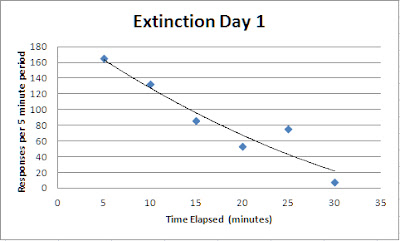Goal:
To eliminate the trained bar-pressing behavior through the use of extinction. Extinction works by restricting reinforcement of a previously reinforced behavior until the organism no longer performs the behavior.
Procedure:
In order to eliminate the behavior of bar-pressing for reward, Tessa was no longer reinforced for performing an bar-pressing. Bar presses did not result in reinforcement, the mechanical sound of the magazine, nor the flickering of the light above the bar in the Operant box. Extinction was performed for thirty minutes on two sequential dates.
Results:
Extinction Day One: Tessa performed 165 bar-presses during the first five minutes of the extinction session. This far exceeds the previous amount of 20 bar-presses required to receive reinforcement. Table 1 contains the running number of bar-presses recorded during the training session. Figure 1 represents the amount of bar-presses performed during each five-minute period.
Table 1
Time Elapsed (minutes)
|
Total Bar Presses Performed
|
5
|
165
|
10
|
297
|
15
|
383
|
20
|
436
|
25
|
511
|
30
|
519
|
 |
| Figure 1. This graph represent the extinction of the bar-pressing behavior. The amount of bar-presses per five-minute period is graphed against total time elapsed. |
Extinction Day Two: Tessa performed 90 bar-presses during the first five minutes of this extinction session. This is much less than the amount of bar-presses performed on Extinction Day 1, indicating that extinction did have an effect on her response rate. Table 2 contains the running total of bar-presses recorded during the training session. Figure 2 illustrates the amount of responses performed during each five-minute period.
Table 2
Time Elapsed (minutes)
|
Total Bar Presses Performed
|
5
|
90
|
10
|
126
|
15
|
145
|
20
|
152
|
25
|
179
|
30
|
184
|
 |
| Figure 2. This graph represent the extinction of the bar-pressing behavior. The amount of bar-presses per five-minute period is graphed against total time elapsed. |
Discussion:
Extinction Day One:
 |
| Cumulative record for Extinction Day 1 |
The effects of extinction on Tessa's bar-pressing behavior are evidenced by the change in response rates within and between extinction sessions. During the first day of extinction, Tessa pressed the bar continuously for the first two minutes before realizing no reinforcement would be given. The fact that she pressed the bar a total of 165 times in the first five minutes may represent an Extinction Burst. When she did not receive reinforcement for the first 20 responses, she became frustrated and pressed the bar over eight times as much as required in the FR20 schedule. She then ceased responding for two minutes, then responded continuously for two minutes, followed by another break from responding for two minutes. Towards the end of the session she went four minutes without responding. These trends indicate that Tessa's bar-pressing behavior was becoming extinct.
Extinction Day Two:
 |
| Cumulative record for Extinction Day 2 |
During the second day of extinction, Tessa pressed the bar in a more intermittent fashion. She would press the bar for less than thirty seconds before taking a break. The fact that she pressed the bar a total of 90 times during the first five minutes of extinction day 2, compared to a total of eight times during the last five minutes of extinction day 1, may represent Spontaneous Recovery of the bar-pressing behavior. Although she should have expected no reward from the behavior, she continued to press the bar at a high rate when reintroduced to the experimental environment. Towards the end of the session, she did not press the bar for a span of about seven minutes. This indicates that the bar-pressing behavior had been extinguished sufficiently.




No comments:
Post a Comment